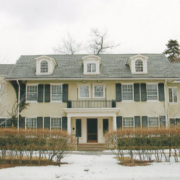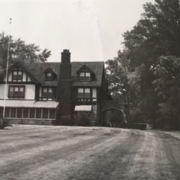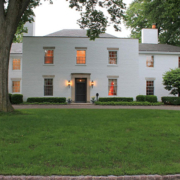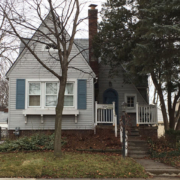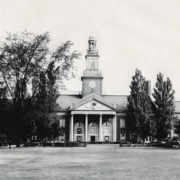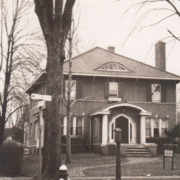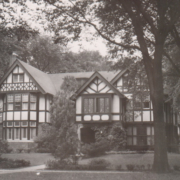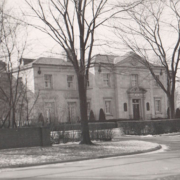Historical Architecture of Grosse Pointe – 330 Lincoln, aka the Waterman House, and the architect George William Graves
Two very talented men, one beautiful house – welcome to 330 Lincoln, one of Grosse Pointe’s most notable residences, designed by George William Graves and home of Cameron B. Waterman, inventor of the outboard motor.
330 Lincoln was built in 1911, and stands on Lincoln, at the corner of Maumee in the village of Grosse Pointe. The 6,800 sq ft stucco Georgian mansion was designed by George William Graves, and is a stunning example of perfect symmetrical Georgian styling. One of the most striking features of the house is the large windows, a typical characteristic of this style of home, as is the large center hall foyer, in this case a grand 250 sq ft in size, offering a stunning entrance to the residence. The floor plan flows seamlessly into the expansive living room (33’ x 16’) and a large dining room (19’ x 16’) both of which had their own sunrooms.
A few years after the main portion of the home was built, Mr. Waterman added a tudor-inspired library and games room to the back of the home (36’’ x 22). The new two-story addition, designed similar to an English Chapel, features an attractive balcony at one end and a large stone fireplace at the other. Both rooms’ feature leaded-glass windows, gothic arches along with oak-paneled and trimmed ceilings and walls. It is said that this room was inspired by the Waterman’s trips abroad and became the perfect venue for large-scale family events.

Mr. Waterman
Cameron B. Waterman had a rich and varied life. Cameron was born in Detroit in 1878 and attended Yale University. He graduated in 1901; during his time at the school he was a member of the rowing crew and served as Captain in 1903. He took his law degree in 1904 and returned to Detroit starting work for a firm specializing in Patent and Trademark Law. Shortly after graduating from Yale, he married Lois Fleming Miller in 1904, and they had three children by 1910.
Prior to his position as a lawyer he had made sketches for a detachable rowboat motor and had put them away for ‘future use’. In 1906, his ideas became reality and the world’s first outboard motor was born, leaving a legacy that has lasted over 100 years. Despite his new invention Waterman continued to practice law, but always maintained a keen interest in inventing new ways to make life better.
Mr. Graves
To accommodate his growing family Waterman commissioned architect George William Graves to design a new home. Graves was born in Buffalo, New York in 1876. After attending schools in Buffalo he later graduated from Buffalo Preparatory College with degrees in architecture and engineering. In 1906 he moved to Chicago, where he resided for two years working as the head of the architectural department of the American Radiator Company. From there he moved to Detroit, working for nearly twenty years at an architectural and engineering practice.
Graves was by no means a prolific architect in Grosse Pointe, which makes his work on at 330 Lincoln all the more special. Aside from his work on Lincoln he also designed 1040 Bishop (Grosse Pointe Park) in 1923. There is however evidence to suggest that Graves was responsible for the design of the Edwin H. Brown house, located at Lake Court. The images below were taken from the 1915 edition of House and Garden Magazine. We were unable to find the exact location of this home and there is also proof to suggest Robert O’Derrick could have been the architect (we would love to hear from anyone who has more information on this property).
Outside of Grosse Pointe Graves designed the Findlater Masonic Temple on Lafayette and the now demolished Masonic Country Club, located at the foot of Masonic Boulevard in St. Clair Shores. He was also heavily involved with the Freemasons.
Both George Graves and Cameron Waterman served in World War 1. Mr. Graves in Detroit while Mr. Waterman was stationed in France. George W. Graves passed away in 1937. Cameron B. Waterman passed in 1955, five years after he was publicly recognized as the true inventor of the first outboard motor.
While neither man was particularly prolific in their field, they were two extremely talented individuals; each leaving a lasting legacy that is still enjoyed today.
Written by Katie Doelle
Copyright © 2015 Katie Doelle

